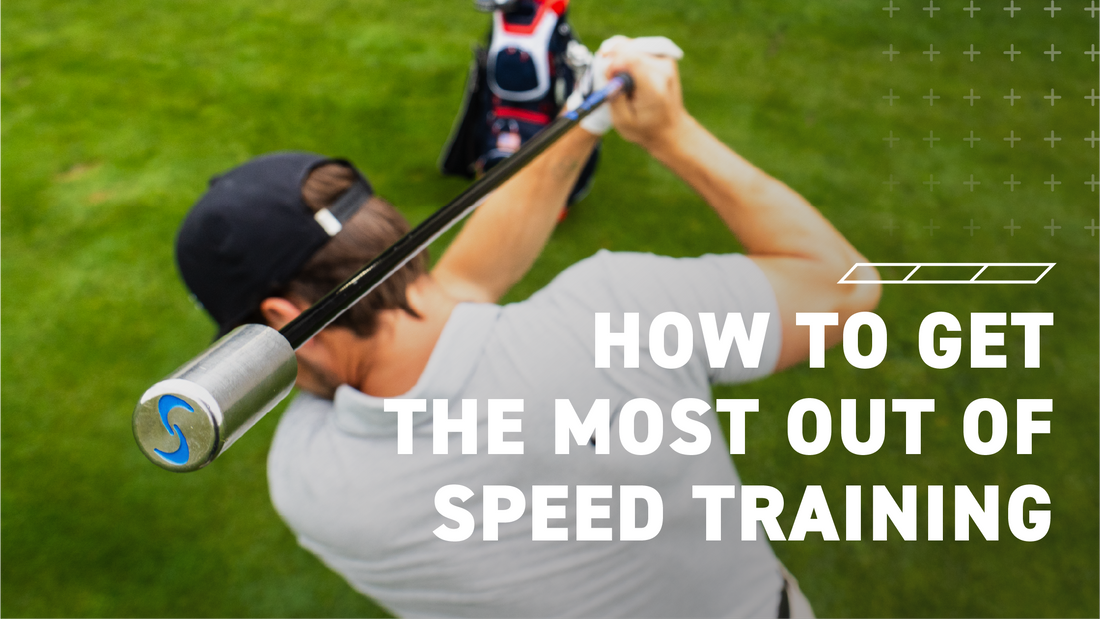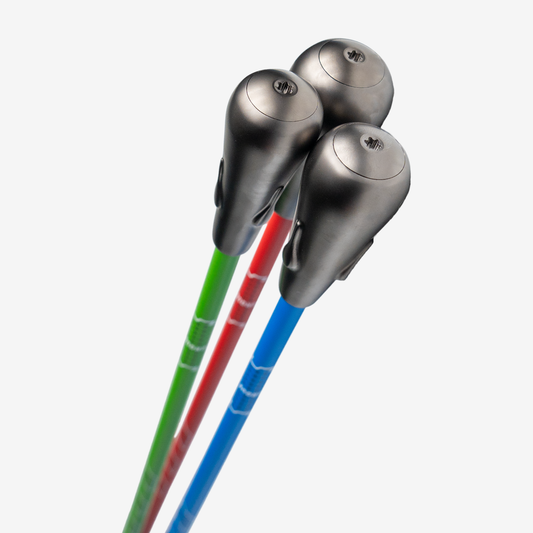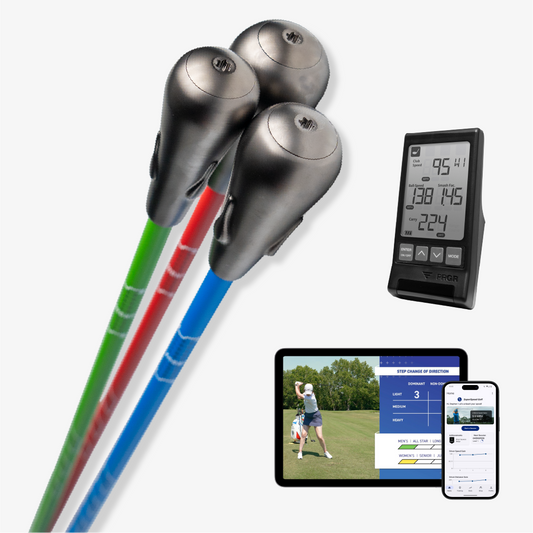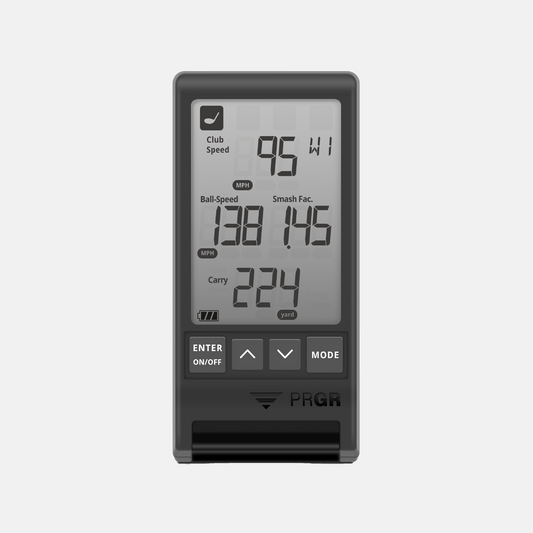A common question we get from our SuperSpeed Swing Speed Training System users is “how can I make sure I gain the most speed”? This article will review the best practices that we have found over the past decade of helping golfers gain speed. Some of them are things to make sure that you do, while some are things to make sure to avoid. All of them have been utilized by our users for years to maximize their speed gains.
1. Between Session Rest (how many days a week should I train?)
It is important to make sure you give your body time to recover from the previous speed training session. We prescribe 3 days a week of speed training with a full day off in between. When in season when you are playing and practicing a lot, it is also important to remember what you are doing out on the golf course that may fatigue you. The best results are going to come from a fresh body. Less is more in speed training so structure your speed training, practice, and gym work to create a fresh body ready to create speed. The use of the PRGR radar to assess readiness is a great way to see if you are ready to train. If your speeds on the first few swings are well below what they normally are, more rest would be beneficial.
2. In Session Rest (Do I really have to take a break before the red club?)
We have done a lot of research to understand when is the best time to rest during a training session. We have found that getting into a bit of a rhythm by making swings in a row can be beneficial to feel how your body creates speeds and to make sure that you can quickly apply those feels. You get a quick natural rest between the left and right side drill positions and between clubs, but we found that after 6 dominant and 6 non-dominant swings your body needs a good 2 minute rest to be ready to create speed on the heavy club. Make sure to take that rest for maximum speed with the heavy club.
3. Warmup (What if I don’t have time for a warmup?)
The warm up serves two very important purposes; the first is to make sure your body doesn’t get injured during the training. Those who gain the most speed are those who can keep training week after week. If you are injured you cannot train. We looked at some survey data of users and found that the best way to avoid injury is to do the warmup before training. A very small percentage of users reported injuries if they did the warm up before training. The second purpose of the warmup is to make sure that your body is ready to go right out of the gate instead of taking 10 swings to get up to speed. It is important to get the joints loose and the blood pumping prior to your first swing with the lightest club so that you can maximize speed on that swing immediately.
4. Ball Speed Applications (Why am I getting faster with air swings, but my driver is not increasing?)
We have always recommended ball speed application programs to our users, taking time to actually practice speed where it matters most, hitting a golf ball with your driver. Working in time each week learning how to hit golf balls at maximum speed ensures that gains can translate out on the course. This is why we created ball speed application protocols that walk you through how to mix in SuperSpeed swings with driver swings hitting a golf ball. These programs will teach you how to add this to your speed training. Ball speed training often unlocks the speed your body was already capable of producing. After a few sessions you may see jumps in your speed just from the aspect of giving your body permission to move faster during your swing.
5. Non Dominant Training (Do I really have to swing from the non-dominant side?)
We find that users gaining the most speed follow the programs as outlined including the use of non dominant training. This is the training that has right handed golfers swinging from the left side and vice versa. So many benefits come from this type of training. A neurological response happens when you mix things up and do similar movement patterns from your non dominant side. This can help immensely with speed gains. Also, it can help balance out some of the rotational speed and power in your core that can help with injury prevention as well. Swinging from the non-dominant side is an important part of trying to maximize speed gains.
6. Footwear (Can I swing in whatever shoes are comfortable?)
Shoes will make a difference in how you swing and generate force through the ground. Make sure you are doing the training in a shoe that gives you proper traction with the surface you are on and the proper mix of stability and mobility you need for your own foot and ankle. If possible doing the training on turf in your own golf shoes can typically fulfill both of these purposes. If you do your training in the gym or on a hard surface, a good athletic type shoe with traction is a great way to go. We have done research showing that shoes make a difference in ground reaction force and speed for golfers. So make sure that you have the right shoes in your training.
7. Gloves (Do I need to wear a golf glove?)
We suggest always wearing a golf glove when doing this training. Similar to on a golf course, that glove is going to help create a more secure connection with your hands and the club, which will give you the confidence to swing with more intensity. We actually suggest that golfers consider adding a second golf glove to their training. This will create even more of a connection with the golf club and can really help you swing with greater intensity. Many of our users report better speeds and gains when using 2 gloves during training.
8. Use of a radar (Is the PRGR radar essential to the speed training?)
While we know that users gain speed with and without the PRGR radar, having a radar can really help to maximize speed gains in a number of ways. One of the biggest benefits of the radar is the ability for you to self coach and organize how your body creates speed. During your speed training as you try different things to create speed, wanting that number to climb higher, you can actually use the radar to see if it is helping. Does a longer backswing cause the numbers to jump? Does a harder push from your lead leg help? Having the radar allows you to find speed each and every session based on your own body and movements. It can also help keep you locked in and engaged in your training, measuring and seeing speeds on each swing helps to ensure you are getting the proper stimulus swing to swing. It also actually gives you measurable swing speed gains. Using it with your driver prior to training and then after tells you how much speed you have gained with your own driver hitting a ball.
9. Proper Intensity (Should I be worried about form or just swing for the fences?)
We always tell golfers that for these 3 sessions a week, just worry about swinging as fast as possible. You will have times when you work on swing thoughts and techniques in lessons, on the range, on the course etc but speed training is meant to be physical. This means from swing 1 to swing 39 you need to be getting your body to move at a high intensity each and every swing. Hair on fire speed, swinging as fast as possible each and every swing is the way to gain the most speed. This will not mess up your form and swing. Fast is typically efficient with better sequencing. The club lengths and weights are designed to be so similar to a driver so that you cannot create speed in improper ways, so go after every swing at the highest intensity possible to maximize gains.
10. Use of the ground (Does it matter what my feet are doing?)
We have done extensive research on how golfers generate speed by using the ground properly. We know that most golfers struggle with this aspect of movement and it can be a great way to enhance speed gains. We have ground reaction force protocols that can help golfers to learn how to push at the right time and in the right places in the swing. These drill progressions in addition to regular speed training enhance the gains experienced by our users.
11. Strength vs speed training (Do I need to get stronger?)
The first 8 to 10 weeks of speed training will definitely unlock speed gains that your body is already capable of producing. This is in the absence of any type of gym or strength work. We know that most golfers are currently operating at speeds below what their current strength allows. That is why we see such great gains in the first few months of training. After that it becomes much more important to think about your body from a more holistic physical aspect. Adding in some basic strength work in a gym setting is the way to create more gains in your speed training. We have worked to develop physical training protocols that will give you the right things to be working on in the gym to help add more to your speed training and enhance the way your body moves and functions.
12. Grip strength (Does it matter how much grip strength I have?)
Our research has shown that grip strength can be a speed limit for many golfers. There is a high correlation between a golfer's swing speed and their grip strength. This means that golfers who cannot generate a specific amount of grip strength may be leaving speed on the table as a result. We always suggest that golfers assess grip strength and our data shows that for most golfers, more grip strength would be helpful in their quest to gain more speed. This can be done by lifting heavy stuff in the gym and carrying them, using grip strength training devices or using the SuperSpeed Squeeze on the golf club to enhance grip strength and the opportunity to gain more speed.
13. Training phases and maintenance phases (Can I just keep speed training 3 days a week all the time?)
The cycle of training phases and maintenance phases are designed to help your body go through periods of intense training and other times of a bit of scale back and rest. The scale back phases can be extremely effective to let your body recover before another intense training cycle. They also are great to help you maintain speed gains over a long period of time especially when you are in tournament play or season where you don’t want to have jumps in distance. Don’t ever stop training! Many of our users will gain speed over 10 weeks and then totally stop training. This is the way to lose speed gains that you have created through all your hard work. Instead of stopping completely, get in 3 or 4 great sessions a month indefinitely. This will help your body stay healthy, move well, and to not just maximize gains but retain that speed throughout your golf career.





